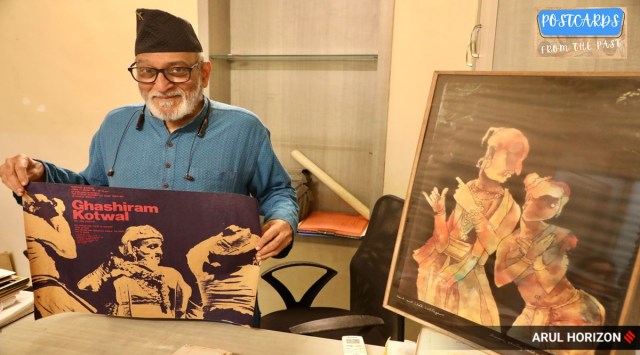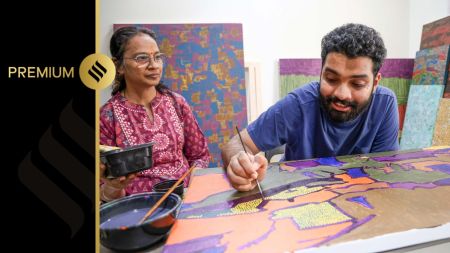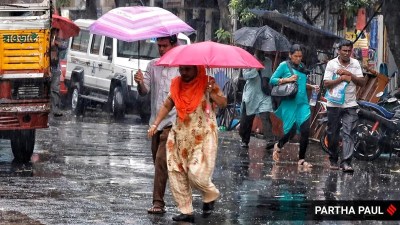- India
- International
Postcards from the Past: When Mohan Agashe played Pinocchio, once demanded Pune’s death certificate
In Pune, Agashe works out of the office of his organisation, 'Developing Awareness Through Entertainment – D.A.T.E'.
 The 75-year-old veteran actor recalled M F Husain's painting of Nana Phadnavis and how the barefoot painter had sketched the actors during a performance of the iconic Marathi play 'Ghashiram Kotwal'. (Express photo)
The 75-year-old veteran actor recalled M F Husain's painting of Nana Phadnavis and how the barefoot painter had sketched the actors during a performance of the iconic Marathi play 'Ghashiram Kotwal'. (Express photo) At Dr Mohan Agashe’s office on Prabhat Road, Atul Kale from the 1974 batch of Nutan Marathi Vidyalaya (NMV)-one of the oldest schools in Pune-patiently sifts through the collection of photographs that has been neatly kept in brown paper packages. The NMV alumni association has been recording interviews of celebrated ex-students and Agashe, from the 1963 batch, has agreed to let them click some of his choicest pictures. “This photograph with Vinod Khanna, it is from the film ‘Rihaee’, and this one with Madhuri Dixit is ‘Mrityudand’, right?” asks Kale.
As he looks up expectantly, Agashe, who is dressed in a royal blue kurta and trademark Nepali Dhaka topi, nods silently. The 75-year-old veteran actor’s attention is then briefly diverted to an M F Husain painting of Nana Phadnavis and how the barefoot painter had sketched the actors during a performance of the iconic Marathi play ‘Ghashiram Kotwal’. Agashe recalls that the cult play had won the second prize when it was first staged at a state-level competition in Pune’s Bharat Natya Mandir in 1972. He had played the role of Nana Phadnavis, an influential minister of the Maratha empire in the Peshwa administration, in the performance that was directed by Jabbar Patel.
But the play also courted controversy. When the Progressive Dramatics Association decided against staging the play due to rising animosity over how Nana was portrayed as a “Machiavellian character”, it was the Pune-based Theatre Academy, which included the likes of Jabbar Patel, Satish Alekar, Agashe, and others, who decided to travel and put up several shows (close to 800) after reopening the production in 1973. Fifty years later, Agashe says that in the late 1970s and early 80s, apart from the Bhagwan Rajneesh Ashram, ‘Ghashiram Kotwal’ was the other must-see on the list of foreigners visiting Pune, at Max Mueller Bhavan, Alliance de Francaise or the American Center. “Believe me, these were the main tourist attractions,” Agashe says. “In those days, going to Koregaon Park and beyond was like traveling abroad. It was a different look with sanyasis in their ochre-coloured robes and traditional malas.”
 Agashe admits that he sorely misses the city that he knew and grew up in. “It does not exist anymore.” (Express photo)
Agashe admits that he sorely misses the city that he knew and grew up in. “It does not exist anymore.” (Express photo)
Playing Pinocchio in his first film
Agashe recalls that his acting talent was noticed by none other than Ramchandra aka Appasaheb Vaze who visited his home and appealed to the young boy’s father to send him for rehearsals of the play ‘Dak Ghar’. Ramchandra was the founding member of Maharashtriya Kalopasak (after his death, the famous Purshottam Karandak annual intercollegiate one-act play competition was started in his memory). “I must have been in Std VII and I remember the play was being planned on the occasion of the birth anniversary of Rabindranath Tagore,” Agashe says.

He was also picked for the acclaimed director Sai Paranjpye’s children’s theatre group. They were part of a play titled ‘Zaali Kay Gamat’ when it was adapted into a film titled ‘Nirupama ani Pari Rani’. Sai wrote the script and Agashe, along with other children in the group, was selected for the film. “The children were excited. This was in 1961 when several parts of Pune were flooded after the Panshet dam burst on July 12. However, the film was not shelved and the children got extra time as schools remained shut for one-and-a-half months to accommodate those who were affected by the floods,” he says. That closure paved the way for Agashe’s first Marathi film that featured noted actress Seema Deo. She played the part of a fairy, while Agashe was Pinocchio. His friend Jyotsna Kirpekar (Chitnis) played a physically challenged girl who was helped to walk by characters from the book she read, such as Peter Pan and Pinocchio.
NDA ruled out, almost rusticated from college
“During college days, young boys often would get coached at Major Bapat’s classes to join the National Defence Academy,” says Agashe. But for him, this career path did not work out as he learned he had flat feet. Then there was a fun fair at S P College that almost got Agashe rusticated from the institution. As Agashe recalls, his friends had tried to “pull a fast one” on him by encouraging him to buy four tickets for Re 1. But when their Hindi professor told him that the rate was actually Re 1 for two tickets, Agashe, “without thinking”, retorted: “Kay gandavtat (how they fool us).” To his horror, the professor pulled him by the collar and took him to the college authorities. “I had made that remark referring to my friends but the professor thought otherwise,” Agashe says. Threatened with rustication, the young man had no option but to apologise.
The good part about this episode though, says Agashe, was that he studied hard and found a place among the toppers. He joined B J Medical College where he became a leading psychiatrist and went on to start the Maharashtra Institute of Mental Health. Theatre, however, remained the mainstay and as general secretary of the B J Medical College Arts Circle, Agashe ensured that top artists like Pandit Shiv Kumar Sharma and Talat Mahmood were brought for events held at the institution’s auditorium.
 Agashe recalls that the cult play ‘Ghashiram Kotwal’, had won the second prize when it was first staged at a state-level competition in Pune’s Bharat Natya Mandir in 1972. (Express photo)
Agashe recalls that the cult play ‘Ghashiram Kotwal’, had won the second prize when it was first staged at a state-level competition in Pune’s Bharat Natya Mandir in 1972. (Express photo)
Agashe, of course, went on to head the Film and Television Institute of India (FTII) in Pune and became a movie producer, too. The latest film that he has produced, “Outhouse”, features Sharmila Tagore and is a tribute to his friend Sumitra Bhave, the national award-winning filmmaker who wrote the script in just two months during the early days of the pandemic before she passed away.
‘My Pune does not exist anymore’
In Pune, Agashe works out of the office of his organisation, ‘Developing Awareness Through Entertainment – D.A.T.E’. He recalls that during his early childhood, Sarasbaug — the famous Ganesh temple and garden known as Talyatla Ganapati — did not exist and cycling trips to Vitthalwadi was a “pleasurable outing”. “Pune was within a radius of five km. Be it Purandare colony, Nanavati colony or Wadia hospital, all were in the periphery of today’s Subhashnagar,” he says, adding that the sprawling Dhamdhere ground is now home to the BSNL telephone exchange.
Agashe admits that he sorely misses the city that he knew and grew up in. “It does not exist anymore.” On this note, he recalls an incident when some members of a city-based industries association sought his opinion on how to contribute to Pune’s culture. When Agashe found that they had no clue about the iconic AryaBhushan Tamasha Theatre, he became livid and stomped straight towards the Pune Municipal Corporation demanding the city’s death certificate!
Click here to join Express Pune WhatsApp channel and get a curated list of our stories
May 29: Latest News
- 01
- 02
- 03
- 04
- 05






































